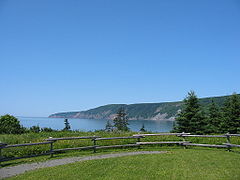
Cape Chignecto
Encyclopedia
Cape Chignecto is a headland
located on the Bay of Fundy
coast of the Canadian
province of Nova Scotia
.
Cape Chignecto is located at the westernmost tip of Cumberland County
and is the western limit of the Cobequid Hills, a low mountain range that is part of the Appalachian Mountains
and extends across the northern part of the Nova Scotia peninsula
.
 The cape bifurcates the Bay of Fundy into Chignecto Bay
The cape bifurcates the Bay of Fundy into Chignecto Bay
to the north and the Minas Channel, leading to the Minas Basin
to the east. Since 1998 the cape has been located within Cape Chignecto Provincial Park
, the largest provincial park in the province and a renowned wilderness reserve. The cape features a rugged topography with reportedly the highest cliffs on the Nova Scotia peninsula.
Headlands and bays
Headlands and bays are two related features of the coastal environment.- Geology and geography :Headlands and bays are often found on the same coastline. A bay is surrounded by land on three sides, whereas a headland is surrounded by water on three sides. Headlands are characterized by high,...
located on the Bay of Fundy
Bay of Fundy
The Bay of Fundy is a bay on the Atlantic coast of North America, on the northeast end of the Gulf of Maine between the Canadian provinces of New Brunswick and Nova Scotia, with a small portion touching the U.S. state of Maine...
coast of the Canadian
Canada
Canada is a North American country consisting of ten provinces and three territories. Located in the northern part of the continent, it extends from the Atlantic Ocean in the east to the Pacific Ocean in the west, and northward into the Arctic Ocean...
province of Nova Scotia
Nova Scotia
Nova Scotia is one of Canada's three Maritime provinces and is the most populous province in Atlantic Canada. The name of the province is Latin for "New Scotland," but "Nova Scotia" is the recognized, English-language name of the province. The provincial capital is Halifax. Nova Scotia is the...
.
Cape Chignecto is located at the westernmost tip of Cumberland County
Cumberland County, Nova Scotia
Cumberland County is a county in the Canadian province of Nova Scotia.-History:The name Cumberland was applied by Lieutenant-Colonel Robert Monckton to the captured Fort Beauséjour on June 18, 1755 in honour of the third son of King George II, William Augustus, Duke of Cumberland, victor at...
and is the western limit of the Cobequid Hills, a low mountain range that is part of the Appalachian Mountains
Appalachian Mountains
The Appalachian Mountains #Whether the stressed vowel is or ,#Whether the "ch" is pronounced as a fricative or an affricate , and#Whether the final vowel is the monophthong or the diphthong .), often called the Appalachians, are a system of mountains in eastern North America. The Appalachians...
and extends across the northern part of the Nova Scotia peninsula
Nova Scotia peninsula
The Nova Scotia peninsula is a peninsula on the Atlantic coast of North America.-Location:The Nova Scotia peninsula is part of the province of Nova Scotia, Canada and is connected to the neighbouring province of New Brunswick through the Isthmus of Chignecto...
.

Chignecto Bay
Chignecto Bay is an inlet of the Bay of Fundy located between the Canadian provinces of New Brunswick and Nova Scotia and separated from the waters of the Northumberland Strait by the Isthmus of Chignecto. It is a unit within the greater Gulf of Maine Watershed...
to the north and the Minas Channel, leading to the Minas Basin
Minas Basin
The Minas Basin is an inlet of the Bay of Fundy and a sub-basin of the Fundy Basin located in Nova Scotia, Canada. It is known for its extremely high tides.- Geography :- Boundary :...
to the east. Since 1998 the cape has been located within Cape Chignecto Provincial Park
Cape Chignecto Provincial Park
Cape Chignecto Provincial Park is a Canadian provincial park located in Nova Scotia. A wilderness park, it derives its name from Cape Chignecto, a prominent headland which divides the Bay of Fundy with Chignecto Bay to the north and the Minas Channel leading to the Minas Basin to the east...
, the largest provincial park in the province and a renowned wilderness reserve. The cape features a rugged topography with reportedly the highest cliffs on the Nova Scotia peninsula.

